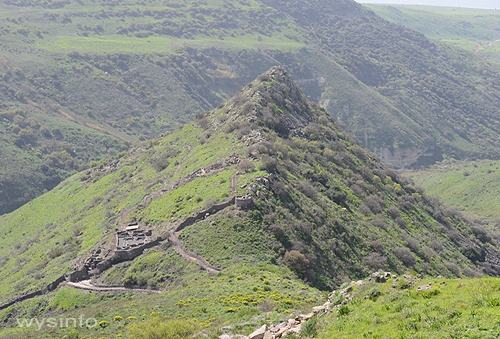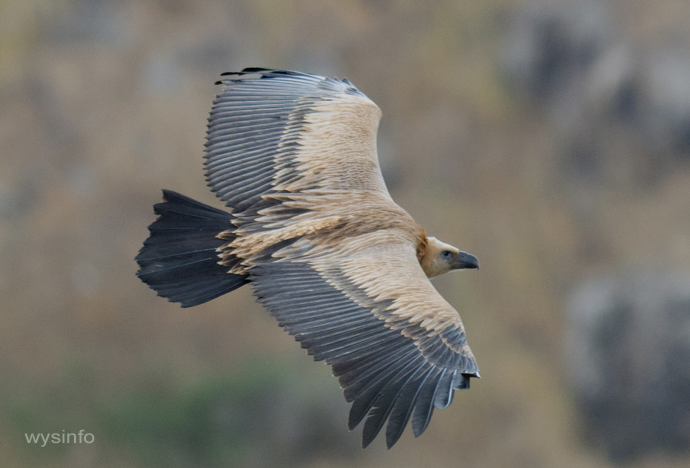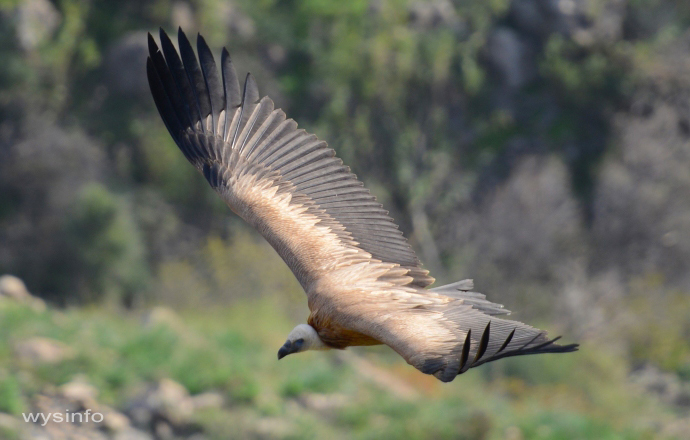Page Content
Related Pages
Predators and vultures have always stimulated our imagination and are associated in our minds with terms like power, strength, struggle, survival, heights, depth, life and death.
During our exploration, searching for vultures and predators along the Syrian-African rift, we found vultures in the north of Israel at the Golan Heights, across the rift and down around the city of Eilat.
One spot particularly captured our attention. This was Gamla, located in the Golan.

What is a Vulture?
Answer: A vulture is a large bird of prey that feeds mainly on carrion (carcasses of dead animals). Unlike other predators, it does not usually kill its prey, but rather is known as a scavenger.
Currently vultures are divided into two groups: new world vultures found in North and South America, and old world vultures found in Europe, Africa and Asia. The vultures of Gamla belong to the group of the old world vultures.
Vultures are characterized by what appears to be bald heads and necks together with sharp, hooked beaks for tearing meat. Why the strange bald appearance? There are different theories that try to answer this question. Some argue that the lack of distinct feathers on their heads helps them to avoid infection that may result from soiled feathers when eating decaying meat. A different theory argues that the vultures often change altitude within a short period of time and that the baldness (or rather the fine feathers that give the appearance of baldness) helps to control heat loss (thermoregulation).
The Story of Gamla

Gamla was an ancient walled city dating from the time of biblical Joshua (the Bronze Age).
Today this is an archaeological and nature reserve site. The fortified city was destroyed and then resettled during the Hellenistic period (mid-second century BCE).
The city, built on a camel-back shaped hill, surrounded by deep canyons and cliffs, joined the Jewish revolt against the Romans in 66 CE. After the Romans destroyed Gamla in 67 CE, it was never rebuilt and was then forgotten for 1,900 years until it was rediscovered in 1968.
Vultures of Gamla
The vicinity of Gamla has been a home for vultures for many hundreds of years. Its vulture population was diminished drastically for various reasons – mainly due to man’s intervention: poaching, high voltage wire electrocution, low flying planes, and so on.

Use of pesticides in agriculture has also been a major factor since vultures are at the end of the food chain. Poisons used to protect agriculture end up in the stomach of creatures that feed on the crops. Eventually the vultures, which feed on such dead animals, are also killed off, thus resulting in a reduction in numbers that has brought them to near extinction.

There is a new approach of green agriculture which has helped to reverse the process. This approach recognizes that birds of prey actually help the farmers by controlling the population of harmful creatures and that vultures are actually the natural janitors of nature thus preventing the spread of disease.
Currently, the deep canyons, steep walls and the relatively large amount of food in the area, coupled with care by regional, state and nature reserve authorities, has helped to increase the vulture population.
Question: What raptors can be seen in the Gamla region?
Answer: Today, Gamla Nature Reserve is a residence to Israel’s largest nesting colony of vultures and other raptors such as various eagles and buzzards.
The raptors in the Gamla reserve include:
- Griffon vultures (Gyps fulvus)
Griffon vultures are one of the largest and most impressive raptors, feeding primarily on carcass. This huge bird can reach a size of 1.1 meters and a wingspan of 2.7 meters. The griffon vulture is one of the birds that left a great impression on our forefathers because of its size and strength. No wonder it is mentioned in the bible some 28 times.

Since they feed mainly on carcass, the Griffon vultures are very important in balancing the ecosystem. Griffon vultures are social birds. They search for food in groups and can cover up to 100 km a day by soaring and gliding on air currents.

Griffon vultures find food in open areas – carcasses of cattle, sheep, wild boars, gazelles and other hoofed animals. These vultures require high, protected areas like the Gamla cliffs to roost and nest.
- Egyptian vultures (Neophron percnopterus)
This species arrives at its nesting grounds in Israel around February and leaves around September – October for its winter quarters in Africa. Its wingspan can reach 1.8 meters and it feeds on carcasses and live prey. It nests on ledges in the cliffs above the streams in the reserve, and usually lays 2-3 eggs.

- Short-toed eagle (Circaetus gallicus)
These birds arrive at their nesting grounds in Israel around February and leave in October to winter in Africa. The short-toed eagle has a wingspan of approximately 1.9 meters. It preys mainly on reptiles and its nest is usually built in the trees, laying one egg.
- Long-legged buzzard (Buteo rufinus)
Part of this buzzard population is resident but some just pass through Israel on their way to and from points south. It has a wingspan of about 1.5 meters. Its diet is diverse, feeding on small mammals, birds, reptiles and at times, carcasses. It builds its nest on the ledges of cliffs and lays 3-4 eggs, usually in March.
- Bonelli’s eagle (Hieraaetus fasciatus)
A rare resident bird, this raptor has a wingspan of 1.8 meters. It feeds mostly on birds, which it hunts in flight thanks to its speed and agility. It nests on cliff edges and lays 2-3 eggs, usually in January
Reviving the Vulture Population
Since the vulture population in this area is considered endangered, efforts have been made by the nature reserve authorities to protect the birds and to stimulate increased population growth.
This has been done by controlling the use of pesticides, by separating and caring for sick or damaged birds and by incubating eggs that are at risk.
There have been a number of instances when vultures have fallen victims to poisoning as a result of irresponsible use of pesticides for agriculture. In one particular case rangers from the reserve watched while a parent vulture died shortly after feeding it’s young. The rangers attempted to save the chick, but unfortunately it was too late – the baby could not be saved.
In the video below you can see expert rangers from the nature reserve authorities who climbed down the cliffs into a vulture’s nest where they identified griffon vulture parents in stress with a baby that was weak and at risk of not surviving.
Expert rangers in Gamla rescuing a baby vulture at risk – Music by Tom Fahy – Op. 7, No. 8 – Die letzte Geburt Haus
***
You can also find our videos on our Wysinfo Youtube channel.